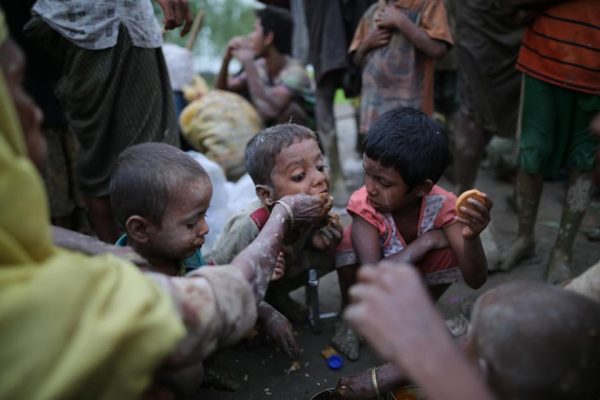
COX’S BAZAR, BANGLADESH – SEPTEMBER 03: A grpup of Rohingya Muslims, fled from ongoing military … [+] operations in Myanmars Rakhine state eat food after crossing the Bangladesh-Myanmar border while they are on their way to reach a safer place in Cox’s Bazar Bangladesh on September 03, 2017. Violence erupted in Myanmars Rakhine state on Aug. 25 when the countrys security forces launched an operation against the Rohingya Muslim community. It triggered a fresh influx of refugees towards neighboring Bangladesh, though the country sealed off its border to refugees. (Photo by Zakir Hossain Chowdhury/Anadolu Agency/Getty Images)
The Rohingya crisis began in Myanmar in August 2017, when the country’s army launched a deadly crackdown on the Rohingya Muslims that also resulted in a genocide. Over 1.1 million Rohingya people were forced to flee from their home country and became refugees. Since August 25, 2017, 711,336 of Rohingya muslims fled to Bangladesh, according to the UN Refugee Agency. They live in the infamous camps near the town of Cox Bazar. Around 55 percent of them are children.
Out of this, in 2017, more than 40 percent of Rohingya children aged 6 months to five years were stunted. The World Health Organization (WHO) defines stunting as impaired growth and development that children experience from poor nutrition.
According to a recent study published in PLOS ONE journal, households in the refugee camps who received e-vouchers were associated with an improved height for age ratio as compared to those households that received food ration. Children are defined as stunted if their height for age is below the WHO Child Growth Standards median.
The lead author of the study, John Hoddinott, professor of food & nutrition economics and policy at the Cornell Institute for Public Affairs, says, after the refugee camps were set-up in Bangladesh, one major concern was how the Rohingya were going to be fed. The responsibility for that falls under the United Nations World Food Program (WFP).
The initial response was to provide the 187,844 households with food rations that consist of rice, lentils, and micronutrient fortified cooking oil. “While those are valuable in keeping people alive and providing them with some calories and proteins, moving food from other parts of the world to Bangladesh is not cheap,” says Hoddinott.
“It also means that the diets these people are receiving through these rations are extremely monogamous. If you could imagine eating nothing but rice and lentils all the time, with no break, that gets pretty touch,” adds Hoddinott.
And so, the WFP looked for ways by which they could cost-effectively provide food assistance to the Rohingya with a greater variety of food items. In the first half of 2018, they started a system where they used vouchers, which is essentially like a debit card with an electronic chip and is handed over to the woman in each household.
They can then take these cards or e-vouchers to 19 designated shops that were set-up in the camps and provide a better variety of foods. The chip enables a monthly payment of $9 that can be made remotely and the Rohingya don’t need to travel to line up at any point of payment. The foods that they can buy using these e-vouchers include not only rice, lentils, and cooking oil but also fruits, vegetables, dried fish, eggs, and various spices.
The prices for each item are negotiated by the WFP. For this study, Hoddinott surveyed 1,308 Rohingya households. Out of that, 62 percent received food rations through the general food distribution and 34 percent received e-vouchers. Only 4 percent received both.
The survey also took into consideration each household’s demographics, consumption, nutritional outcomes, and coping strategies, among other parameters. Enumerators from the Bangladesh Institute of Development Studies and Action Against Hunger collected data, which Hoddinott used to analyze households with children between 6 and 23 months.
Children who fall within this age bracket are also in what is called the “1000 days window” which is critical for a child’s nutrition as they are no longer being exclusively breastfed. In this study, 161 children live in households that are receiving the e-voucher.
“One thing, however, that was not known at the time because there’s relatively little evidence is to what extent this might affect the nutritional status of children,” says Hoddinott. “There are two measures that are typically used, one is the length for height and height for age set scores.”
This way, these children’s heights are assessed relative to international standards for the same age and sex. That is also a measure of longterm or chronic nutritional status. There’s a second measure called weights for height set scores, which is a measure of short term or acute nutritional status.
“We wondered whether there was any association between receipt of the e-vouchers and children’s nutritional status. To be clear, this is an association study,” adds Hoddinott.
“So, this is not the result of a randomized control trial with all the caveats that that entails. But with that caveat, what we found is that children in households receiving the e-vouchers exhibited better markers of chronic nutritional status,” he explains. “Their height for the length or age set scores were higher relative to children and households and received the food ration.”
The study found that children in households receiving the food ration had a poorer height for age ratio and were more likely to be stunted, 36 percent, as compared to 27 percent of children in households receiving the e-voucher.
But, Hoddinott says that the impact on stunting in his study was somewhat imprecisely measured. “Our results suggest stunting is reduced, but the degree of statistical significance is not particularly precise,” he adds.
While there is some uncertainty about whether or not e-vouchers can help in reducing stunting among young Rohingya children, it could help.